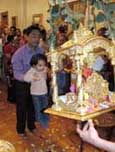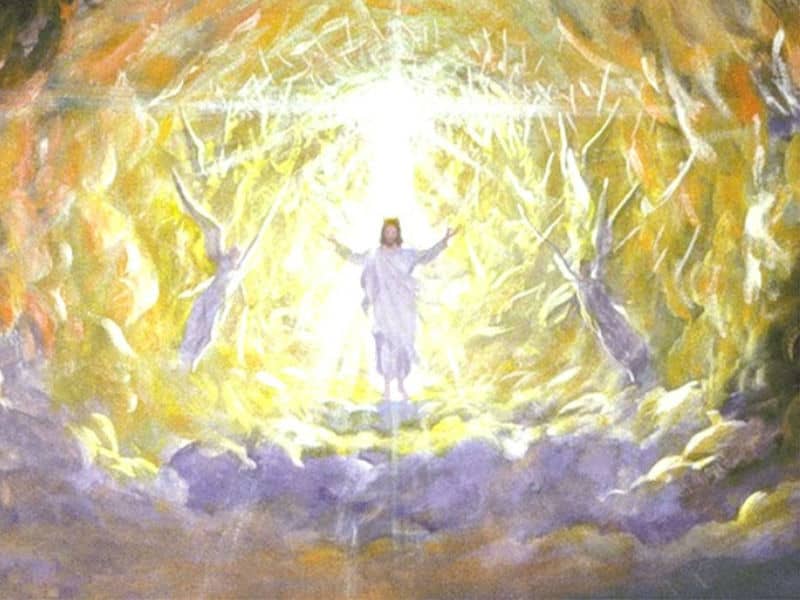 |
| A Janmashtami celebration at Boston's Hare Krishna temple |
Yet one anecdote encompasses it all: as a naughty child hankering after butter, he would stand on the shoulders of other children to reach the pots of butter that hung from the ceiling. His mother, sure the incriminating proof was in his mouth, ordered him to open his mouth. She was mesmerized to see entire universes in the child's mouth, and knew then that all the incidents were merely part of the Lord's Leela or celestial play.
Janmashtami--the birth of Lord Krishna--is Aug. 16 this year. It is little surprise that devotees gather in the hundreds, in the thousands, in temples across India and around the world. It is a very special and festive day, and they wait in anticipation, surrounding the symbolic baby crib, singing devotional songs. It's a day of exuberant celebration befitting the birthday of a beloved deity, yet Janmashtami also has a much deeper message: It's a reminder to do one's duty in life, no matter how difficult, and to keep on the path of dharma, to surrender one's life to Krishna because all else is maya, or illusion.
The story behind the birth of Krishna is intriguing, and one most Hindu children have grown up with: the wicked King Kansa had been told that he would meet his death at the hands of his yet unborn nephew. To thwart that, he had his only sister Devaki and her husband Vashdev imprisoned, and murdered each of their seven sons as they were born.
Just as the eighth child--Lord Krishna--was born, the prison locks magically opened and Vashdev managed to escape with the baby Krishna in a wicker basket on his head. The river was raging but touching the divine baby's feet, it receded. Krishna was brought up by a simple cowherd Nand and his wife Yashoda, and the evil Kansa did meet his death at his hands, as it was foretold.
Krishna is the vanquisher of all evil and the guide for right living. In the mighty Mahabharata war in which the Pandavas battled their kinsmen, the Kauravas, he drove the Pandava warrior Arjuna's chariot and instructed him to perform his duty, to be on the side of dharma or righteousness. When Arjuna hesitated to fight against his own brethren, Krishna enlightened him with wisdom that encompasses all aspects of living. These words are immortalized in the 700 slokas of the Bhagavad Gita or the Song of the Lord, which has sustained people across the world.
Why do Hindus love Krishna so much? He is the all-pervading, omnipresent One without whom even a leaf cannot stir, but he assumes a very accessible human form, becoming babe, naughty child, son, friend and lover. There is an instant bonding and connection between this deity and his devotees because Krishna is all about love.
Krishna is very much a part of a Hindu's life: Many children are named after him – the deity has hundreds of names so there's plenty to choose from! Interestingly, Krishna is a name for both male and female children and the parents certainly hope they will take on his shining attributes. Everything associated with Krishna is auspicious--there's even a Krishna Savings Bank in Delhi and a Lord Krishna Bank in Kerala!
Krishna's devotees are also found in the movement commonly known as the Hare Krishnas--formally called the International Society for Krishna Consciousness--that was started in the United States by A.C. Bhaktivedanta in the 1960s and which now has centers all over the world. You may have seen the Hare Krishna devotees dancing on the streets or at airports.
Walk into a Hare Krishna temple and you see that same blissful abandon before the images of Krishna. Vegetarian feasts are served, free for everybody, based on the many delicacies that Krishna loved--butter, ghee, and milk.
In addition to ISKCON temples, Janmashtami is celebrated with pomp and pageantry, with dance performances and skits of Krishna's life, in the many temples throughout America that were founded since the 1960s by Indian immigrants.
"Janmashtami, the birth of Lord Krishna at midnight which is the darkest moment of the night, symbolizes that the Lord manifested Himself from the prison cell, thus vigorously illuminating the universe, dispelling the darkness of ignorance," says Dr. Uma Mysorekar, president of the Hindu Temple Society of North America.
Having grown up in New Delhi, I have vivid memories of the Janmashtami celebrations at the pink sandstone Lakshmi Narayan temple, which was lit up beautifully. In the gardens of the temple complex is a pond in the middle of which a statue of Vashdev carrying the Baby Krishna on his head had been set up. I still remember it and the festive air as hundreds pushed to get a better view. Janmashtami is a time of devotion, as I found at a recent celebration in New York where hundreds crowded into a temple in Queens, singing, dancing and chanting.
Many devotees also fast on this day, eating only after midnight, says Pundit Mahesh Shastri, a Hindu priest in New York. He explains that the icon of Krishna is bathed in milk, yogurt, ghee, honey, sugar, and water. A traditional prasad or benediction is given to all the devotees--the Panchajiri, made of five ingredients, in North Indian temples while South Indian temples favor puffed rice, a great favorite of Krishna.
In India, the day after Janmashtami is one of revelry, keeping with Krishna's fun-loving spirit. Clay pots of curds and butter are suspended from poles in the streets in towns like Mathura and Vrindaban, where Krishna lived, and also in cosmopolitan cities like Mumbai.
Bands of boisterous youth form human towers to get to the pots, mimicking Krishna's exploits. To shouts of 'Govinda Ala Re!' (Govinda is coming!), colored water is thrown on bystanders and participants--and yes, the pots contain money for those daring enough to reach them.
The revelry is fun, of course, but it's much more than a birthday bash for Krishna. Underlying the celebration is the importance of devotion to Krishna's teachings. As the Lord explains in the Bhagavad Gita: "Before creation I alone existed. There was nothing, neither existence nor non-existence. I am that which remains after dissolution."

